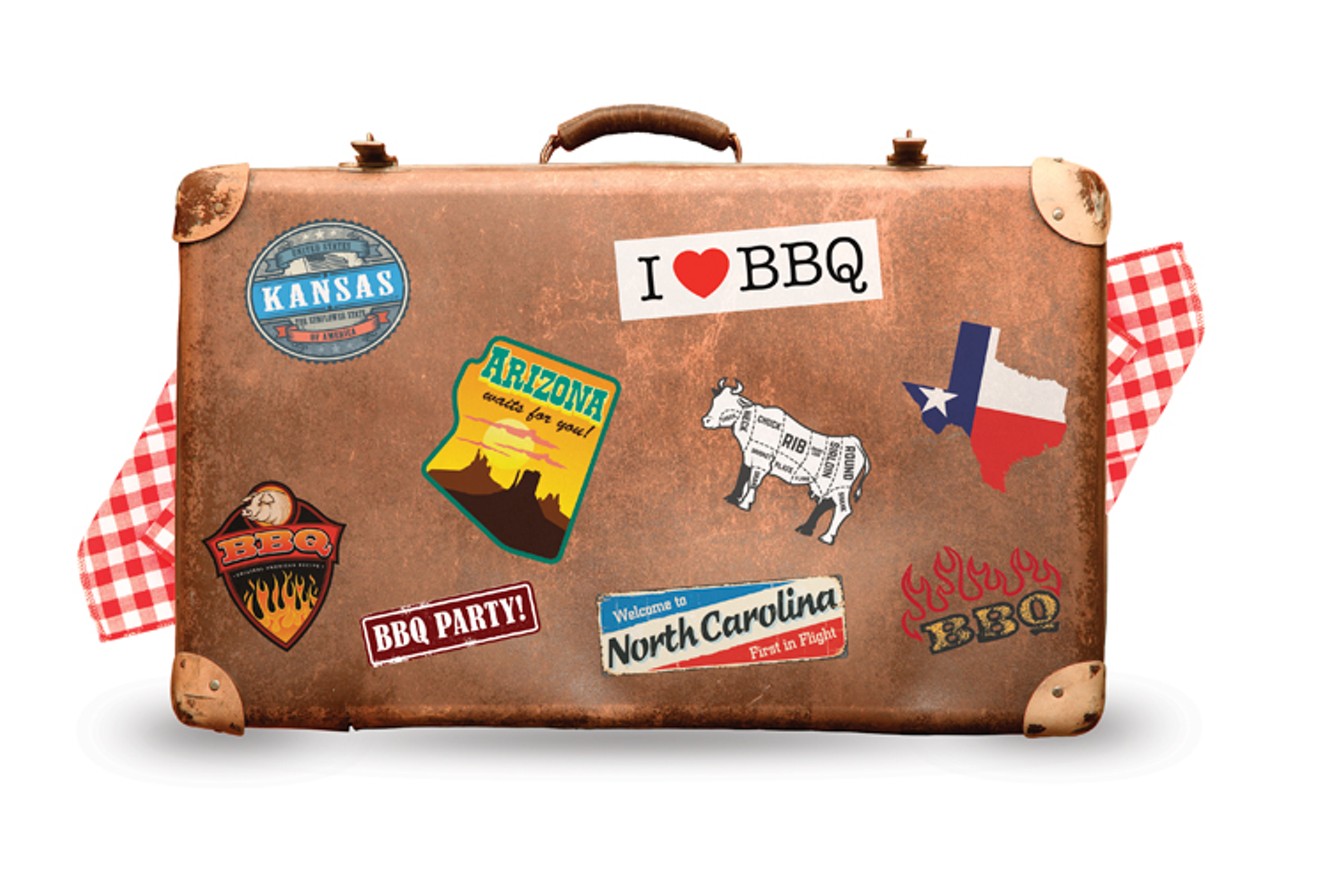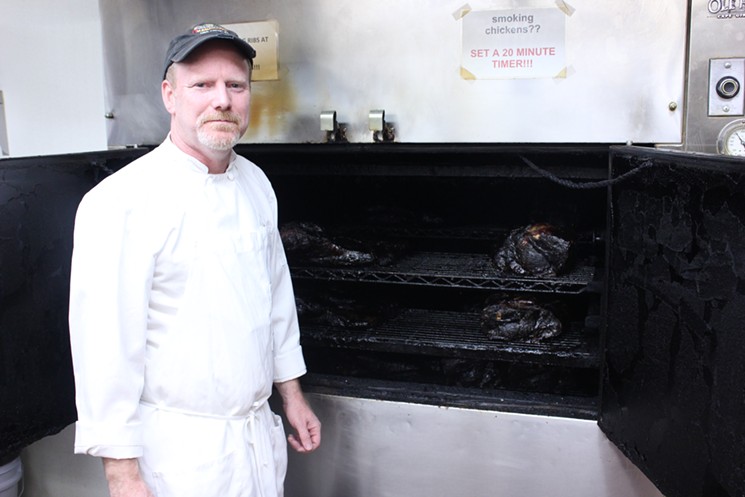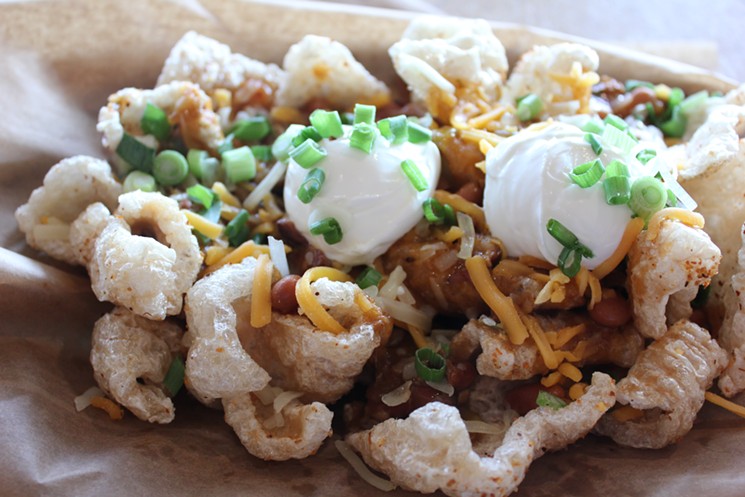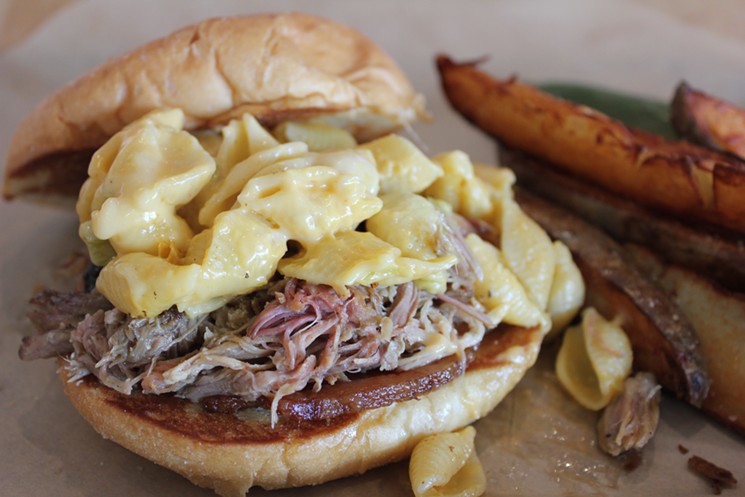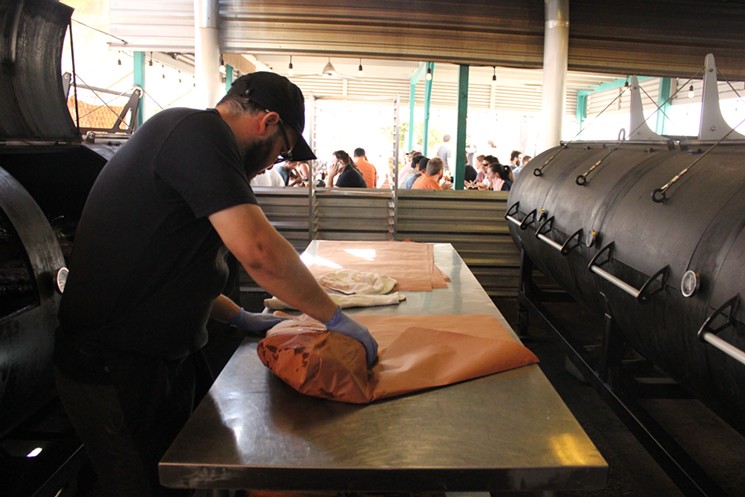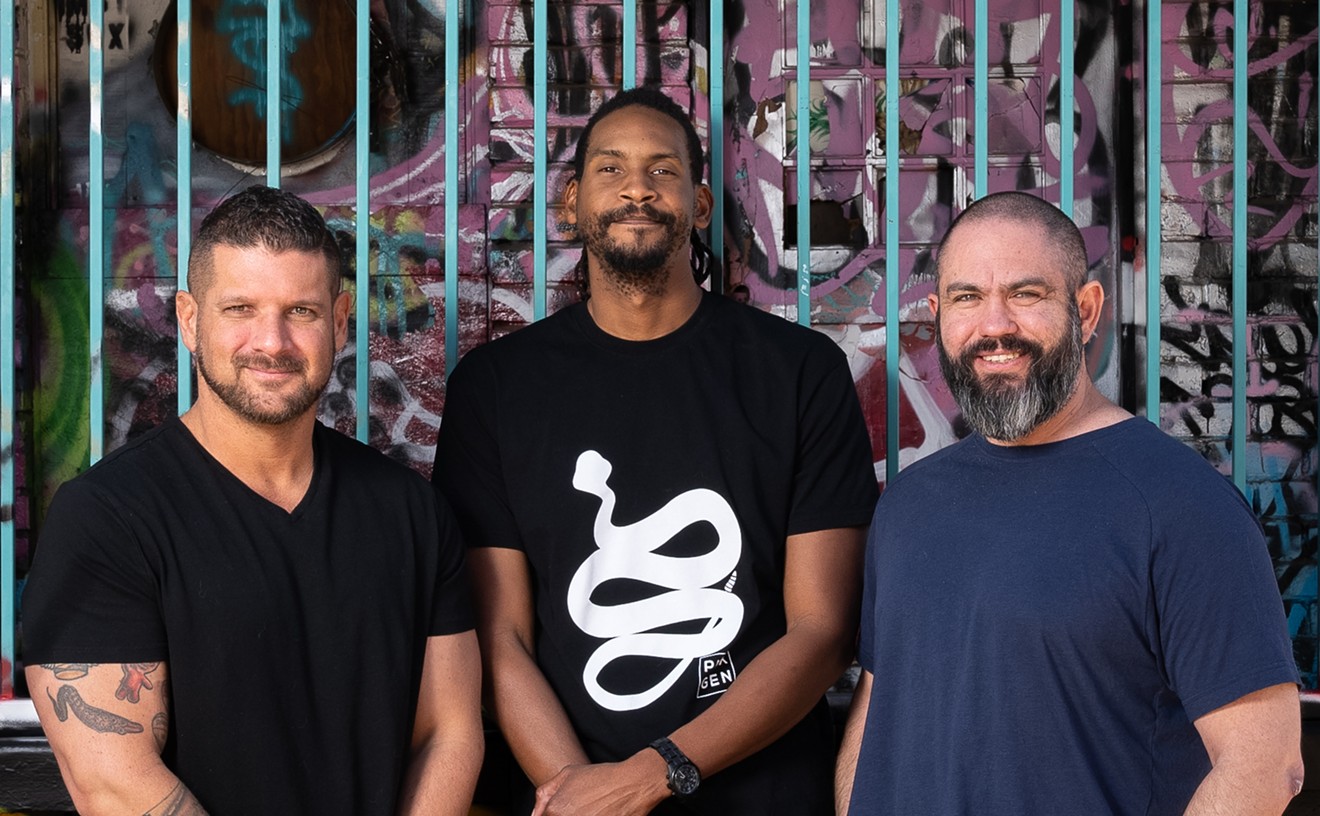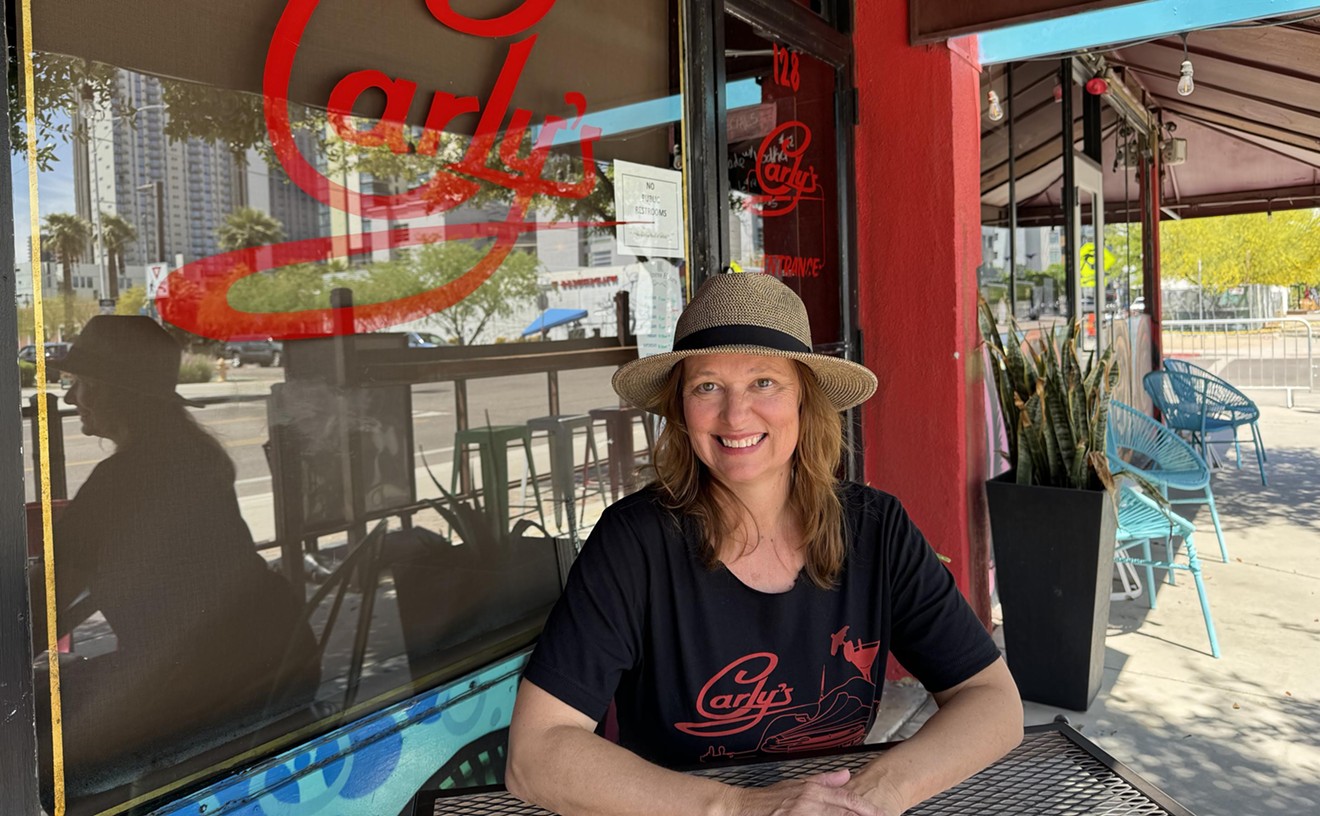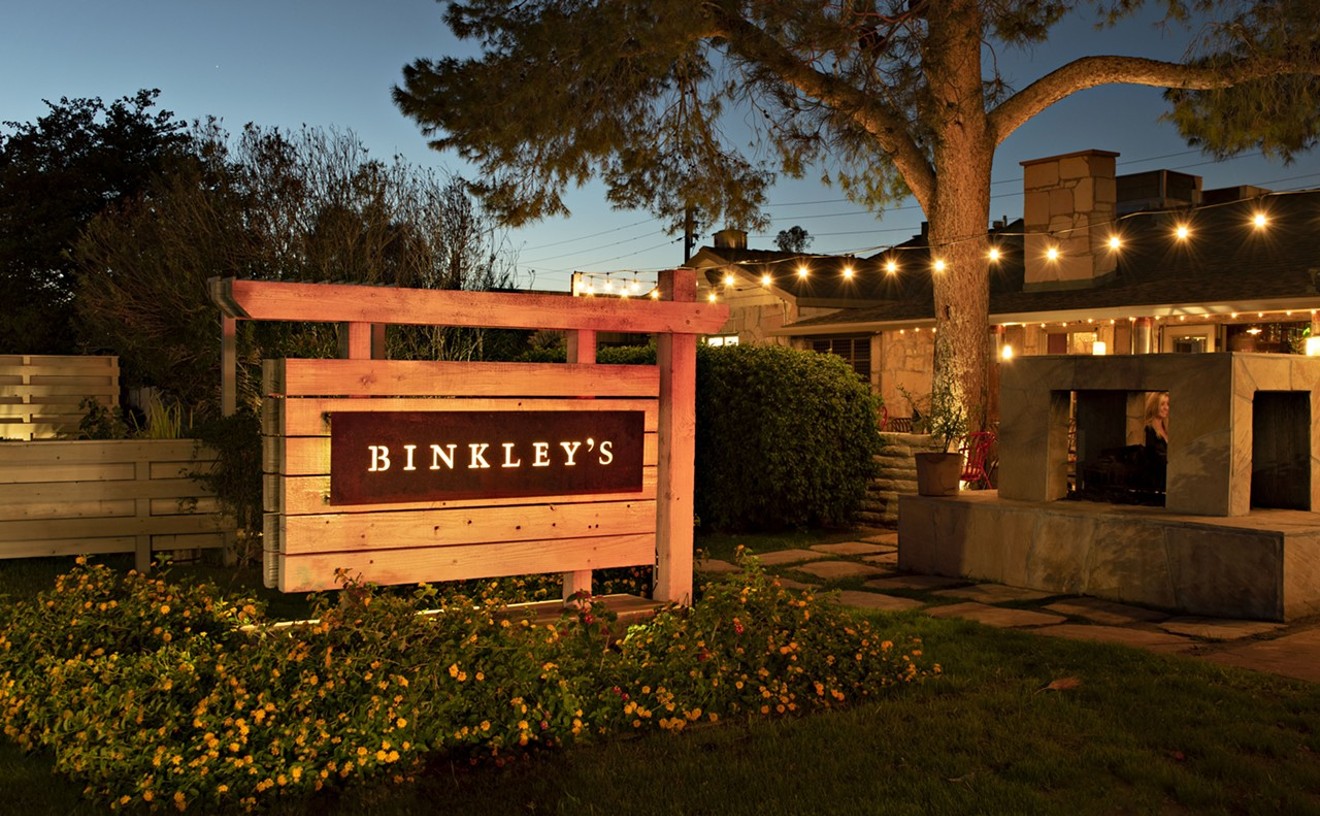Narrowly, the verb “barbecue” means to cook meat with smoke. “Barbecue” the noun refers to smoked meats as well as the glorious tradition of making of them. That cuisine, born in the Caribbean and brought to the U.S. through the Atlantic slave trade, has evolved to perfection in the red-white-and-blue.
American barbecue — the particular customs we have developed for smoking brisket and ribs, pork and the rest — may be the only American food that can hang with the world’s greatest. We’re talking a culinary tradition evolved into our own that can match Japanese sushi, Italian pasta, Thai curry, and Mexican tacos.We’re talking a culinary tradition evolved into our own that can match Japanese sushi, Italian pasta, Thai curry, and Mexican tacos.
tweet this
But any carnivore worth his or her pork butt knows that “barbecue” means different things in different places. Sauces and styles vary from the Carolinas to Alabama, from Memphis to Kansas City, and even within subregions within states, such as from central to west Texas.
Today, there is even a Phoenix barbecue. Or is there?
Given the somewhat recent explosion of barbecue joints here, there may be. In an effort to pin down whether a “Phoenix-style” barbecue exists, I’ve started to eat my way through the Valley’s ’cue scene.
The outline I’ve traced so far in ash and sauce and gnawed ribs seems to suggest that, hell yes, there is a Phoenix-style barbecue.

Over the years, Hartman made ’cue for cookouts and tailgating, not as a professional but as a hungry guy who likes smoking meats and eating them with family and friends. Eventually, he left his long career in sales with a Fortune 500 tech company to live the gospel of smoke and meat.
Hartman’s former corporate travels have shaped his approach. He was often on the road for work, and he sought out local barbecue when possible.
Hartman calls his restaurants Naked because the meat comes without sauce. His rubs tend to be simple, leaving the meat unmasked. He avoids pungent woods, such as mesquite, that camouflage flavor behind assertive musk.
At the center of Hartman’s ethos is this understated approach. With sauce, smoke, and rub dialed low, meat’s flavor has room to shine through.At the center of Hartman’s ethos is this understated approach. With sauce, smoke, and rub dialed low, meat’s flavor has room to shine through.
tweet this
“Other guys put a lot more smoke on the meat,” Hartman explains. “We’re putting a mild, moderate smoke on. We’re buying the highest-quality meats we can, so we don’t want to cover them up too much.”
Even Naked’s spicy sauce, one of four house-made barbecue sauces, has a dim note of heat. But don’t confuse simple style for simple flavor.
Between the two locations, Hartman smokes 15 to 20 briskets a day. Each weighs about 18 pounds and reduces by half its weight while cooking. Smoking them takes at least a whole night and lasts 14 to 16 hours. Near the end, Hartman wraps brisket in butcher paper to keep it moist.
His travels have led him to aim for a central Texas-style brisket.
Texas is known for brisket. Daniel Vaughn, barbecue editor at Texas Monthly, has christened central Texas “the promised land of barbecue.” He outlines central Texas barbecue in his book, The Prophets of Smoked Meat, as a style in which “spice-rubbed meat is cooked over indirect heat from pecan or oak wood.”
That’s precisely what Hartman does.
The Ferris-wheel rotisserie provides indirect heat from the right kinds of wood. And his brisket is light on the smoke, huge on primal flavor.
For pork, Hartman uses a more voluble, 12-spice rub. “We’re not trying to get too complex,” he says. “Just letting the meat come through with a little bit of seasoning.”
Hartman’s reserved style reaches its apex with beef short ribs, another Texas tradition, one that lives up to what they say about the size of everything in the Lone Star State.
A handle of bone shaped like the head of a cricket bat extends from Neolithic beef slabs that, each more than a pound, look cartoonish. The ribs have dark crust on the top and bottom, and pure give within. Each beef short rib costs $20 and comes with two sides. Short ribs are available on Saturday nights until they run out.
Hartman’s ’cue game is strong. The Valley is lucky to have a talented newcomer so far outside the country’s barbecue belt. Though Hartman came late to the smoke game, his brisket and destiny may have been entwined from the beginning. He shared a college dorm at Wisconsin with the famous barbecue writer and pitmaster Adam Perry Lang.
Hartman pulls from greatest American hits. He also takes his own approach. His style cherry-picks from other styles, and when you consider him next to other Phoenician pitmasters, the dots start to connect.
Long before he started smoking brisket, pork butt, ribs, and half-chickens in Cave Creek, Bryan Dooley studied at the Culinary Institute of America in Hyde Park, New York. Dooley also cooked for 13 years at the Fairmont Scottsdale Princess. He knows classical technique and fine dining. And with his culinary chops, Dooley has chosen to make a living smoking meat — to barbecue.
“I’m not a pit boss,” Dooley insists. “I’m a chef who specializes in barbecue.”
His mastery of technique comes in on the edges. It shapes the outer flavors of Bryan’s Black Mountain Barbecue: the sauces, the sides, the non-barbecue dishes that depend on the likes of preserved lemon tartar sauce (for frog legs) or smoked tomato remoulade (for a fried artichoke po’ boy).
More remotely, Dooley’s experience informs the core of what he does: smoke meat. It shapes his ’cue on a faint and intangible level. It gives him a feeling-based general competency that can’t really be reduced to specific culinary maneuvers or decisions.
“Barbecue is about smoking meat with fire,” Dooley says. “We don’t want to mess with that so much.”
Like his grandfather, an Alabaman who barbecued in a pit of “cement blocks and metal grates,” Dooley keeps things simple. He has to. Though he has sauced and sautéed, when the smoker gets hot, all Dooley has are three elements: “meat, fire, and wood.”
He makes skillful use of the smoky trinity.
Dooley’s brisket has, sinking a half-inch below its bark, a florid crimson tinge. You can ask for brisket lean or fatty. The fatty brisket has the usual butterlike dissolve of expertly slow-smoked meat. It tastes like beef but also has a nutty perfume and fleeting caramel and toasted notes.
Like Oren Hartman, Dooley aims for mild smoke that will let the meat’s flavors sing. He achieves this smoke by plugging pecan wood into the basic “meat, fire, and wood” equation.
Aaron Franklin, renowned pitmaster of the recently fire-damaged Franklin Barbecue in Austin, shares wood wisdom in his book Franklin Barbecue. “Wood is important for two functions: providing heat and supplying smoke,” he writes.
The kind and age of wood will have great influence on brisket’s final character. Smoke is a strange heat source. It isn’t the steady blue flame of a gas stove or an oven set to 350. Smoke cooks and flavors food. Franklin advises barbecue acolytes to “approach your wood pile like a chef approaches his spice rack.”
That isn’t much of a leap for Dooley, fine dining vet, to make.
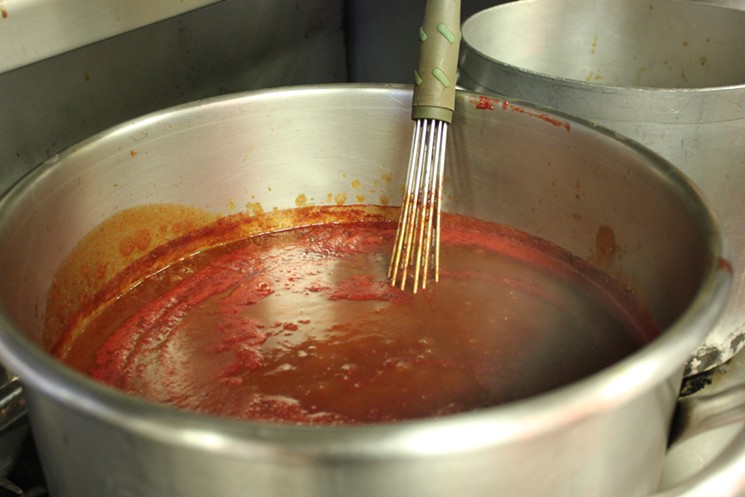
It’s 100 percent pecan wood for Dooley. He gets cords from a supplier who sources from Native American land near the Salt River and down near Tucson. Arizona is known for pecan wood. Pima County is one of the three largest pecan-producing counties in America.
Dooley’s briskets are as black as the space between two stars. Gnawing in, you expect the bitter explosion that comes with such a char. There is none.
tweet this
The benefits of pecan wood can be tasted in Dooley’s burnt ends — the tougher bites from places where the brisket tapers to awkward shapes and doesn’t allow for long, neat slices. Dooley’s are as black as the space between two stars. Gnawing in, you expect the bitter explosion that comes with such a char. There is none.
Same with the pulled pork, smoked to heavy darkness. Bark yields to the tooth with a sticky, taffylike chew with some crisp. Rocking even harder are the single morsels with both bark and pink shreds of melting inner pork, which has a sweet, nutty flavor. The near-translucence of pecan smoke allows for these nuances.
Dooley smokes brisket and pork butts for 12 to 14 hours. As the smoker hums in the kitchen, John Wayne and Western actors bluster on a projector screen in the dining room. Bryan’s seats 150 people. The joint is on Cave Creek Road, the Western town’s main drag.
Two of the edges where Dooley’s training most shapes his barbcue are his rub and sauce. He uses one rub for his meat. It mixes more than 15 spices, including salt, pepper, garlic, chile powder, thyme, and ginger.
Lamb shank and the occasional run of alligator spareribs are as fancy as his ’cue gets. His style is less chef sieving sauces the way chefs have for centuries — more simplified and in tune with a fire-based cooking method that goes back millennia.
Cooking with smoke defies recipe. Pecan wood chopped a few days ago burns differently from wood laid away last year, and smokers have hot and cold spots just like grills. As Dooley’s approach hints, barbecue is more of an instinctive, go-by-feel, Jedi style of cooking.
“To me, barbecue is a feeling,” he says when asked to define the term barbecue. “The feeling you get when you’re eating it. Barbecue comes in may different styles, but they all give you that same comfort feeling. That’s what we’re trying to pursue. It’s bigger than just throwing some meat over some coals, or over some wood.”
One of the drivers of this quest for Phoenix barbecue is the ashy zeitgeist. This decade, Valley pitmasters have fired up their smokers and opened their doors in droves. Faced with such a robust and developed barbecue landscape, what goes through the mind of a relative novice who wants to start smoking professionally in fall 2017?
Mark Nichols says he thinks about flavor.
The chef and newly turned pitmaster opened Arizona BBQ Company with his wife, Colette, in Gilbert in September. Mark was classically trained at Le Cordon Bleu. Unlike Dooley, Nichols applies his training to smoking meat. The result is that European technique and American cuisine merge.
“I don’t think there’s one right way to do anything,” Nichols says. “And that includes cooking.”
Two facets of Arizona BBQ Company untie it from convention.
First, Nichols operates beyond the hallowed smoke-and-fire barbecue tradition, utilizing a pair of cooking methods instead of sticking to the time-tested one (smoking). Nichols finishes smoked meat — brisket, ribs, pork butts, and chickens — with a braise. Take his brisket.
He loads fat-laced briskets into his smoker for six hours a pop, puts them in pans over mirepoix (chopped carrots, celery, and onion), covers them, and gives them a bake. The brisket’s rendered fat cooks the vegetables, which flavor the meat in the timeless French style. The result is brisket that develops a corned-beef-like texture, parts of the fat hued an ivory yellow.
Pork gets a similar braising treatment, minus mirepoix but plus beer. Chicken and ribs, too, are plucked from the smoker and gradually finished in the oven.
This method of smoking and braising, Nichols says, “captures fats rendered out in long smoking.”This method of smoking and braising, Nichols says, “captures fats rendered out in long smoking.”
tweet this
The second way Nichols’ barbecue departs from tradition is in how it’s served. His eatery has the Arizona influence its name suggests. Tortillas and jalapenos come with smoked meat platters. One of his sauces uses habaneros, another chipotles. Smoked meats come alongside — and often mingled with — essential Southwestern flavors.
This isn’t wholly alien. Other barbecue spots in the Valley give barbecue a similar treatment. But Nichols may push the Arizona angle a little harder; he even uses Arizona mesquite in his 50-50 blend of mesquite and oak. His Myron Mixon MMS72XC H20 Smoker can handle, at once, 72 racks of ribs, 162 half-chickens, 90 pork butts, or two whole hogs.
His use of mesquite is key. Oren Hartman and Brian Dooley find mesquite too pungent. Nichols, however, only smokes brisket for six hours. He must use mesquite to reach a base level of smokiness that would be impossible to attain with milder woods over his abridged smoking period. Mesquite gives rapid birth to ashy vibes. If Nichols used just oak, his meat would probably lack the smoky depths that make barbecue barbecue.
Looking at the menu of mixed-meat platters but also tacos and chicharrones, Arizona — more so than Texas or elsewhere — is the place that comes to mind.
“The concept is really about giving a nod to Arizona,” Colette Nichols says. “You know, as opposed to your Memphis style or your Carolina style or anything like that. We really like to take our style and say, ‘This is what Arizona is.’”
Nichols is undaunted by the market. He has long experience as a corporate chef, has spent time as a caterer, and has an approach that makes him something of a barbecue outlier. One month into operations, the smoking has been mostly smooth.
He and Colette did have an issue with a brisket supplier, whose slabs ranged from 12 to 19 pounds. They are switching to a source that always slaughters at 1,500 pounds, resulting in a more consistent product.
Consistency is key to minimizing one of the thousand barbecue variables: meat size. The road to heavenly smoked meat is paved with pitfalls, ranging from wood moisture to room temperature.
Smoking meat ain’t easy.
Nichols’ cooking method yields meat juicier than your typical ’cue. The drawback to pairing mac and cheese, chili, and avocado crema with barbecue is that the microgrooves of the meat’s ultra-nuanced flavors often get lost. Smoke can engender the lush flavor landscapes that make barbecue spectacular. That said, the goal of barbecue is delicious smoked meat — not sticking with methods calcified before the Hoover administration.
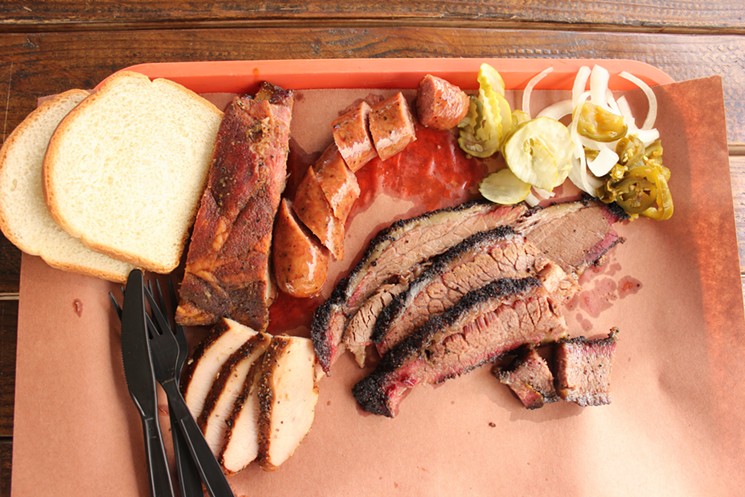
The path of Scott Holmes’ life changed when he traveled to meet the parents of his now-wife, Bekke. Bekke’s parents live in Austin. After meeting Scott, Bekke’s parents took the two to Salt Lick BBQ in Driftwood, Texas. Salt Lick is a Texas legend.
“It’s an old building made of stone,” Scott recalls. “You walk in and there’s a giant pit. You’ve got briskets, pork ribs, sausages hanging down. It’s just the coolest thing ever.”
When he returned to Phoenix, Scott bought a smoker.
He and Bekke opened Little Miss BBQ nearly a decade later. Little Miss BBQ smokes and serves in the central Texas style. The style emphasizes minimal rubs, use of oak and mild woods, sauceless meat, brisket obsession, and such quirks as doling out meat on butcher paper and with slices of white bread.
But by no means is Scott afraid to experiment. He has a fine-tuned sense of when to stick with custom and when to split.
If I had infinite hunger and time, I could sit at Little Miss eating fatty brisket forever. In your mouth, the brisket melts almost like custard or cheese. The sinews holding the meat together offer zero resistance. What you get is a molten dissolve coupled with a blast of intense flavor. The rub has chew and stick, making the meat’s vanishing act even more magnificent.
What sets Little Miss BBQ apart?
To make great barbecue, you must start with great meat. Scott has a fluid rapport with his supplier, Midwestern Meats in Mesa.
“John’s a good guy over there,” he says. “If I didn’t like a meat and I could tell him why, he would look for something else. And then we would try a whole bunch of things until we found something that was perfect.”
To have great barbecue, you must have a great place to chow. Little Miss’s porch is just that. Tunes bathe picnic tables where a mushrooming crowd of brisket-seekers awaits an 11 a.m. opening like kids await a midnight showing of Harry Potter. String lights hang, smoker hinges wail, the thwack of wood being chopped resounds, and fireboxes puff. An aura of community flows; you get a thrill that you’re alive and there.
But — let’s be honest — Little Miss’s three smokers seal the spell.
Most Phoenix barbecue spots use gas-assisted smokers. These use propane to keep heat at a certain temperature. Gas-assisted smokers are commercially available, and the best ones will set you back a few grand.
Scott, pitmaster at Little Miss, built two of his three smokers from 1,000-gallon propane tanks. The third he bought in Texas. Each of his smokers runs on the heat of a wood fire — and nothing else.Scott, pitmaster at Little Miss, built two of his three smokers from 1,000-gallon propane tanks. The third he bought in Texas. Each of his smokers runs on the heat of a wood fire — and nothing else.
tweet this
Why does this matter?
“We get a ton of air flowing with these,” Scott says of his offset smokers. “We believe it helps render the fat better than something where there’s a really high-moisture environment.”
Gas-assisted smokers don’t have a continuous inflow of fresh air. Rather, the same air lingers in the insulated chamber throughout the smoking process. Because the chamber is closed to the outside world, everything inside stays wetter. The process is more fixed and hands off. You don’t have to worry about the size of the fire, the convection inside the main chamber, or how hard the smoker’s smokestack pulls.
Not only is Scott masterful in his use of smokers, he has tailored his smokers to his liking. The first smoker he got was the one from Texas. Based on his experience with it, he made changes when rigging his second and third. Superior smoking equals superior barbecue.
A few other factors set Little Miss apart. One is use of rub.
The 24 to 27 briskets that Little Miss can load into a 1,000-gallon smoker at a time are rubbed with a blend that strays from central Texas tradition. There are some in central Texas who hold that brisket should be rubbed just with salt and pepper. Nothing else. The point of this minimalism, like Oren Hartman’s and Brian Dooley’s, is to cast a stronger light on the meat.
“To season brisket, you can play with different seasoning recipes,” writes Scott Roberts, pitmaster at Salt Lick, in his Salt Lick Cookbook. “Some people just use salt and pepper. Others use a lot of spices. For the Salt Lick, we keep it to a simple three ingredients: salt, pepper, and cayenne pepper.”
Scott Holmes uses a brisket rub that combines a handful of spices and coarse salt and pepper. The rub doesn’t add much pizzazz in the way of flavor — keeping with that minimalistic central Texas approach — but departs from tradition some in its ingredients. The key feature of the rub is its three-dimensionality of it once cooked: the heft, the height, the chew.
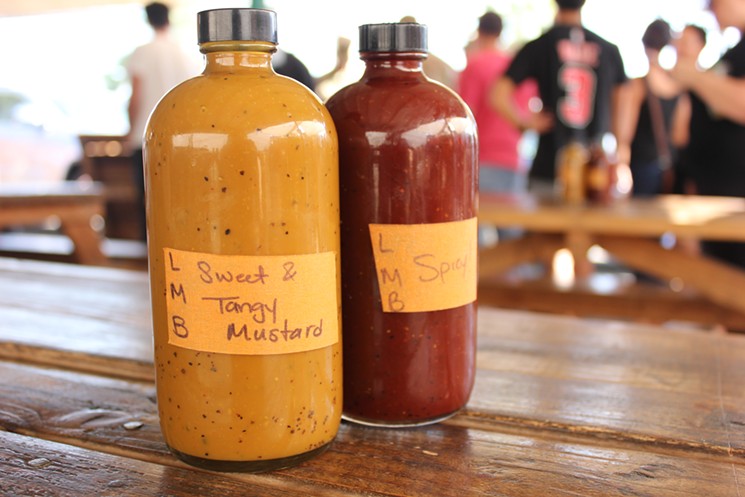
Most barbecue joints use the same wood every time. Little Miss uses mostly two kinds of oak (one from Roosevelt Lake), Arizona pecan, or pistachio wood (though not as much as formerly when it was more available). But that’s not all.
“We’ve had days where we’ve cooked all mesquite, all orangewood,” Scott says. “We’ve used all cedar. We’ve used all eucalyptus. We’ve used olive wood. Nobody knows the difference.”
Scott is a wood wizard. He loves using olive wood to put a delicate smoke on links, stuffed in-house from odd bits left over from his other meats. He can expound at length on how vertically split cords will burn compared with rounds, and on why this matters. But when Scott says nobody knows the difference, he’s dead wrong.
When I visited Little Miss, Scott and I shared a barbecue platter: brisket, sausage, ribs, and surprisingly juicy turkey. I asked him what wood type he used to smoke the meat before us. He wasn’t on smoking duty the night before, and he didn’t know.
That is, until his next bite of brisket. He chewed quickly, looked to be in deep thought for a heartbeat or two, and nodded. He said, still chewing: “Predominantly pecan.”
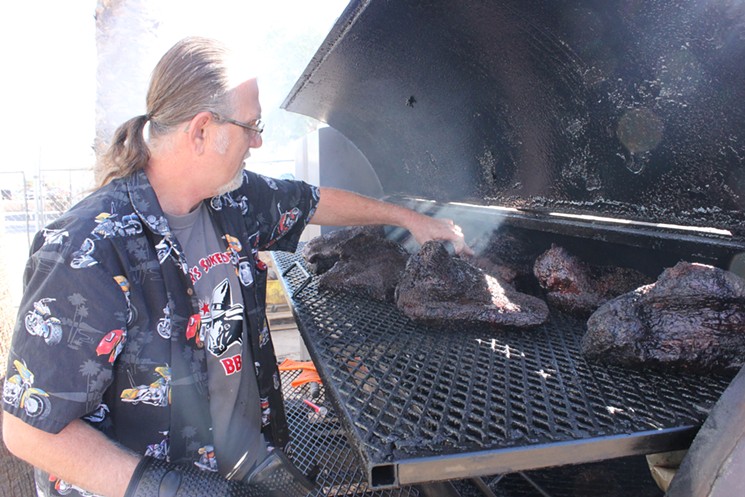
Given what I’ve seen at these spots and others, there are commonalities, aspects that could be tenants of a Phoenix-style barbecue. These tenants are followed more loosely than those of the country’s traditional barbecue meccas.
Here, at last, is the rough draft of Phoenix barbecue.
First, Phoenix-style barbecue makes use of Arizona pecan wood. Arizona is known for pecan growth and production. Barbecue cognoscenti know pecan wood as mild — ideal for spotlighting the glorious nuances of smoked meat.
Second, experimentation is a hallmark of Phoenix barbecue. Untethered to generational traditions, Phoenix pitmasters have the freedom to get creative — to mess with woods, to smoke gator and lamb, and to alter the sacred smoking process by utilizing other cooking techniques.
Third, the Valley of the Sun’s pitmasters look to central Texas for wisdom. Central Texas is the star around which the rest of American barbecue spins. Texas, too, is the nearest great barbecue state, and the easiest to visit. Customs with roots in central Texas crop up again and again here in Phoenix: serving on butcher paper and with white bread, beef short ribs, emphasis on brisket, papering brisket, use of milder woods, and so forth.
Fourth, Phoenix barbecue tends to use chiles on the edges. Powdered chile pepper is in virtually every rub I’ve encountered. The majority of places offer a habanero or chipotle barbecue sauce. Pickled chiles often come with meat platters. Chiles also appear in nontraditional smoked meat dishes like tacos, chili, and mac and cheese.
My search for Phoenix barbecue is only beginning.Next, I’m going to be exploring an issue that could be central to a Phoenix style: how the Mexican traditions of carne asada, barbacoa, and other smoked meat figure into things.
tweet this
My search for Phoenix barbecue is only beginning.
Next, I’m going to be exploring an issue that could be central to a Phoenix style: how the Mexican traditions of carne asada, barbacoa, and other smoked meat figure into things. Arizona abuts Sonora and is lucky to have other Mexican states with strong meat traditions as neighbors. It’s the nature of cuisine to evolve, combine, split, and evolve some more. In Phoenix, the hard line between American and Mexican barbecue has blurred.
This series will be getting more into sides, woods, pitmasters on the fringe, and conversations with all kinds of far-flung folks, such as professional meat scientists. I hope you follow along through all the nerdery, carnivorousness, and smoky glory.
Know a place I should visit or someone I should talk to? Reach me at [email protected]. Looking forward to hearing from you and getting your take. Follow the Phoenix barbecue journey at phxfood.com.

